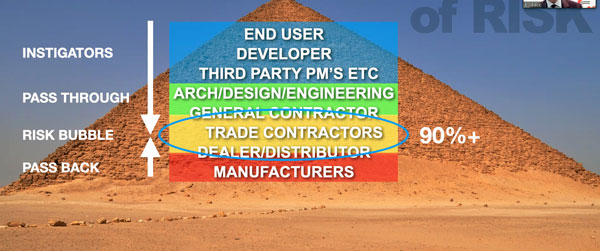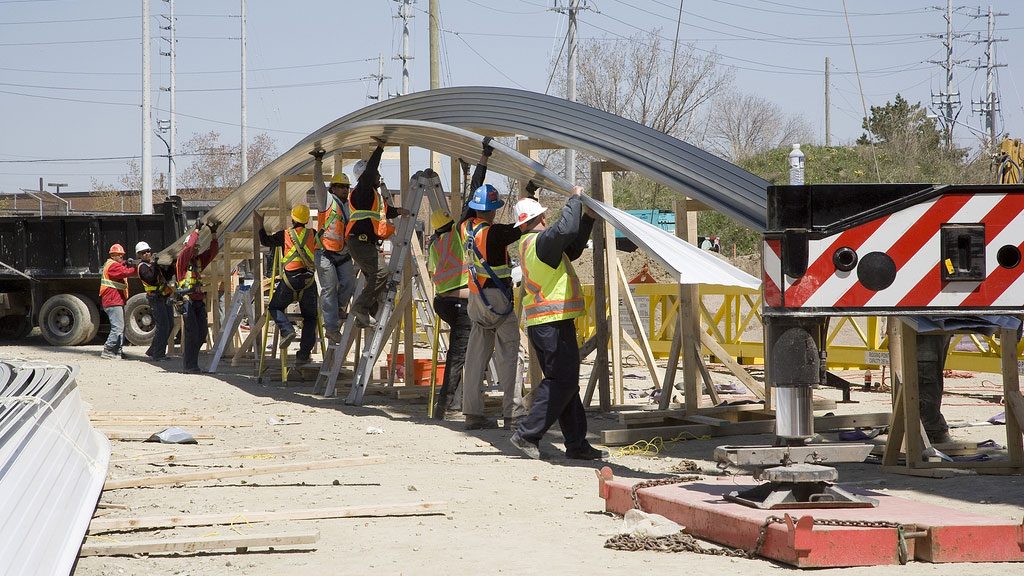Calgary Construction Association president and COO Bill Black pulled no punches outlining the multiple weaknesses of the Canadian construction industry during a recent keynote address but expressed confidence there are enough leaders with resilience and character to develop the solutions needed.
Black, a veteran of 40 years in the business with experience in the commercial trade contractor sector, spoke on June 22, the first day of the Lean Construction Institute of Canada’s (LCIC) three-day training program. He had addressed the “dysfunctional” state of the industry during the inaugural LCIC conference in 2016 and returned to revisit the theme with an address titled Broken Industry: Where Are We Now?
“Nobody’s coming to rescue our industry. This is something we have to do ourselves,” said Black after reciting such problems as escalating risk, short-term thinking, inter-sectoral squabbling, dwindling labour supply and a race-to-the-bottom mentality.
“We have all the tools. Despite everything we’ve dealt with, our industry is one of the most resilient industries around. The work ethic of people in our industry is without compare, and some of the people in our industry are the best people that you could ever want to do business with.”
In 2005 Black was a founding member of the Mindshift consortium created to develop leadership in project delivery. The group co-authored a guidebook and Black went on to become an advocate for integrated project delivery and lean principles.
“We became called Mindshift because that’s exactly what it’s going to take.”
But now, in 2021, Black said, he has to face the truth that little has changed in the industry.

“The scary thing is for me, I obviously failed in my commitment to the Mindshift mission. Writing the book obviously doesn’t do you any good because very little of this has permeated into mainstream thinking, never mind mainstream action.”
The elephant in the room, the source of so much dysfunction in the sector, Black said, is risk. Everyone tries to push it away, and it’s generally shifted onto those who are still waiting to get paid.
But risk isn’t going to go away, Black said. In general, the industry should pay one of the parties in a project to assume the risk, then everyone can observe it, learn from the exercise and eventually reduce risk through better practices.
“The worst thing you can do is try and hide it. It’s like nuclear waste, you can bury it, but it’s still there. Risk should be allocated to the qualified entity that becomes the priority risk holder and everybody else should know that.
“That way you only pay for it once.”
Other “brutal facts” that the industry labours under are procurement practices that keep layering on more and more complexity, small margins and lack of diversity, said Black.
“We tend to be seen as a white, male-dominated industry.”
There is such a lack of responsibility that insurance becomes the answer to problems rather than stakeholders dealing with issues through conversations. Black cautiously discussed a recent major project in which a general contractor decided to make a significant claim on a trade supplier.
“The comment that came was, ‘Why do you care, your insurance is going to pay for it.’ ”
The sector tends to live with a few eternal tropes, Black said: “ ‘We’re so desperate for work, we’ll take it at any cost. If I can pass the risk on, that is OK, that’s just how do I do business, I can take it. I can take the job low and make it up on change orders.’ ”
Solutions exist, Black said, and they start with finding good people. He noted the late Joe Strummer of the rock group The Clash used to say he was nobody without the people around him.
“We need to look for good people, train them, hold on to them, leverage them, engage them, light a fire under them.”
Smart recruits who understand the value of innovation will become the adopters of new technology, and that will bring the results that the rest of the industry is missing, said Black.
“Stop doing old things. Innovation isn’t just about new things. Innovation is actually more about stopping old habits.”
The industry is capable of great feats, Black said. Alberta constructors came together in remarkable fashion during the pandemic to keep projects going safely.
“We had a municipal senior individual who was one of the ones that could have shut us down turn right to us and say, ‘Your industry should be teaching others how to deal with this crisis,’ and then followed up with the absolute gem: ‘You know what, I’ve seen what you guys can do. The construction industry may just be the safest industry to work in during a pandemic.’ ”
Follow the author on Twitter @DonWall_DCN.











What’s the main point of this article? Since 2005, there has been increasing risk involved in design and construction? You need participants to identify their potential risk and take steps to mitigate it? You should have good people working in design and construction delivery? We should be more innovative in the design and construction delivery process? All good things that good practitioners will practice. The not-so-good practitioners screw-up and go broke. What’s the point of this article?
Stephen, sure the article was unfocused but i think Bill Black was looking to address the stance that the strong survive and the rest are screwups. My experience is that those at the top of the construction pyramid increasingly use their position to shift risk onto trade contractors. For all the talk of IPD, Lean, prompt payment, BIM, and so forth my experience is that there is less collaboration, less interest in innovation, and less input from subs than 15 years ago.